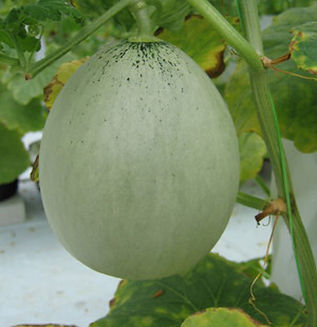
Photo: Melons growing in Autopot® Single 12" Hydrotray with no medium
Rooftop Sweet Melon
This is a project being undertaken by the government to try to get youth in to farming. Modern methods of farming may be more appealing to them than the old ways.
Kuala Lumpur has a typical tropical climate. Always hot and humid, averaging a maximum temperature of 32 deg. C in the day time and 28 deg. C during the night. Humidity averages 90%. Heavy thunderstorms are common and occurs on average, every second day. Total rainfall per annum is around 250 cm.
Here, on top of a commercial building within the heart of Kuala Lumpur, we have 2,000 Sweet Melon plants growing happily in open sided hot houses. Rainwater collected from the 800 sq m of canopy over the hothouses is more than enough to serve the 2,000 plants. Note the growing medium used - broken bricks the size of golf balls.
Over the years, we have developed and perfected the Autopot® technique (very different from all other hydroponic systems such as NFT and drip to waste) of accurately dosing the nutrients to the plants without the salt build up problems many hydroponics experts expect. There is no run-off and no flushing is needed. The yields are good and the flavour of the melons are consistently outstanding. The sweetness measures an average brix reading of 14. The fruits are uniformed and free from blemishes.
Having solved one problem by using rooftops for highly efficient crop production however, we created another problem. This is the lack of natural pollination by insects, particularly bees. To overcome the fruit set problems, we have to use hand pollination. Transferring bee hives to the rooftop was the targeted option, another option was to use chemical sprays that can make the female flowers develop into normal fruits without pollination. Other than that, the crop did extremely well.
The rooftop project was very successful. The melons harvested were consistently sweet. However not all melons are of the same size, they vary between 1.2 to 2.5 kg per fruit. That is a problem because the buyer from a large supermarket chain prefers all fruits to be around 1.2 kg each. One way to do this was to restrict the size of the fruit to within a specified dimension that would give 1.2 kg in weight.
Due to the novelty and appeal, we also attempted to produce a square fruit. The middle picture showing our first attempt in achieving that objective.
These fruits were much more marketable and in these days of high freight costs, we were able to save by packing more fruits into a container.










